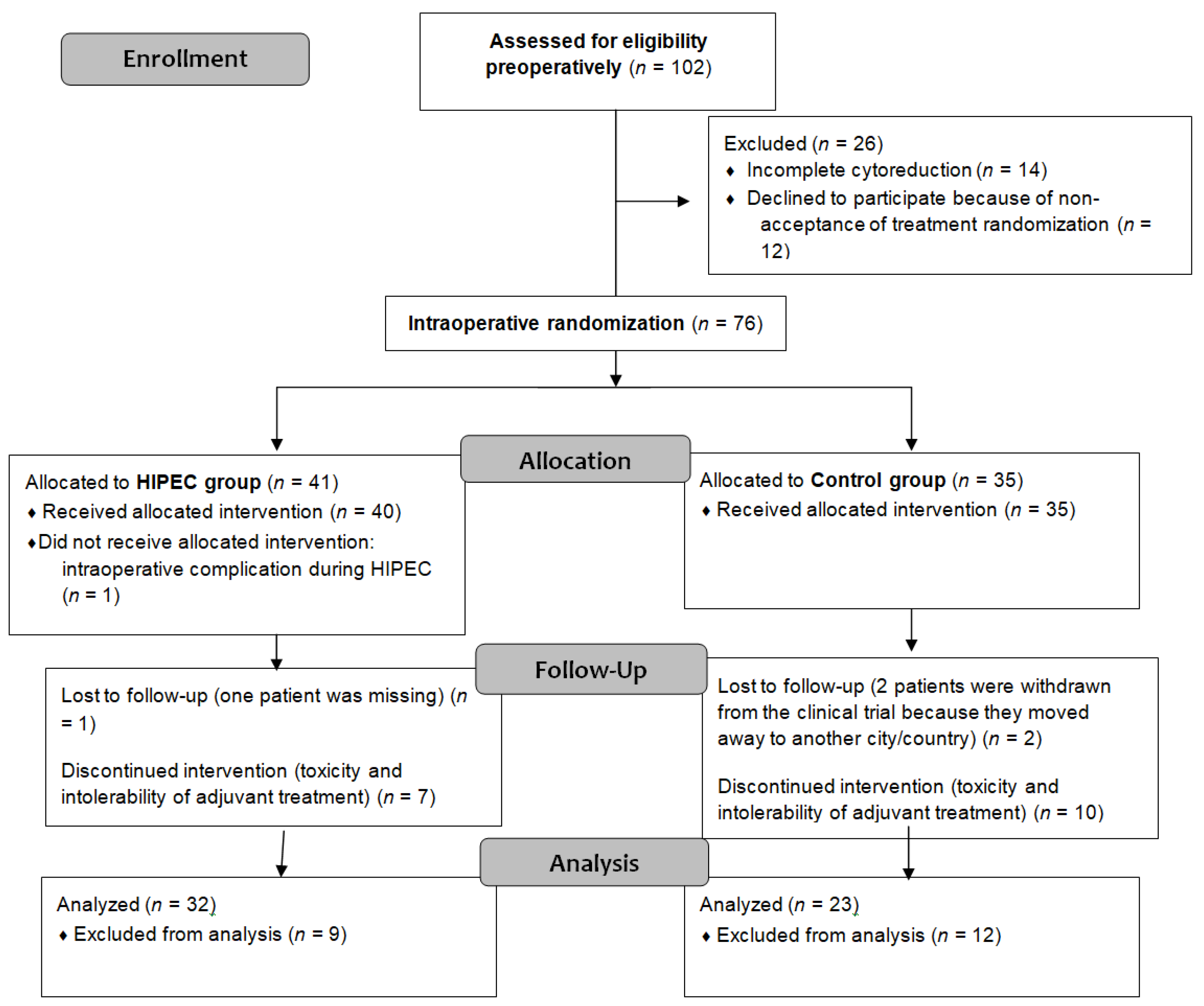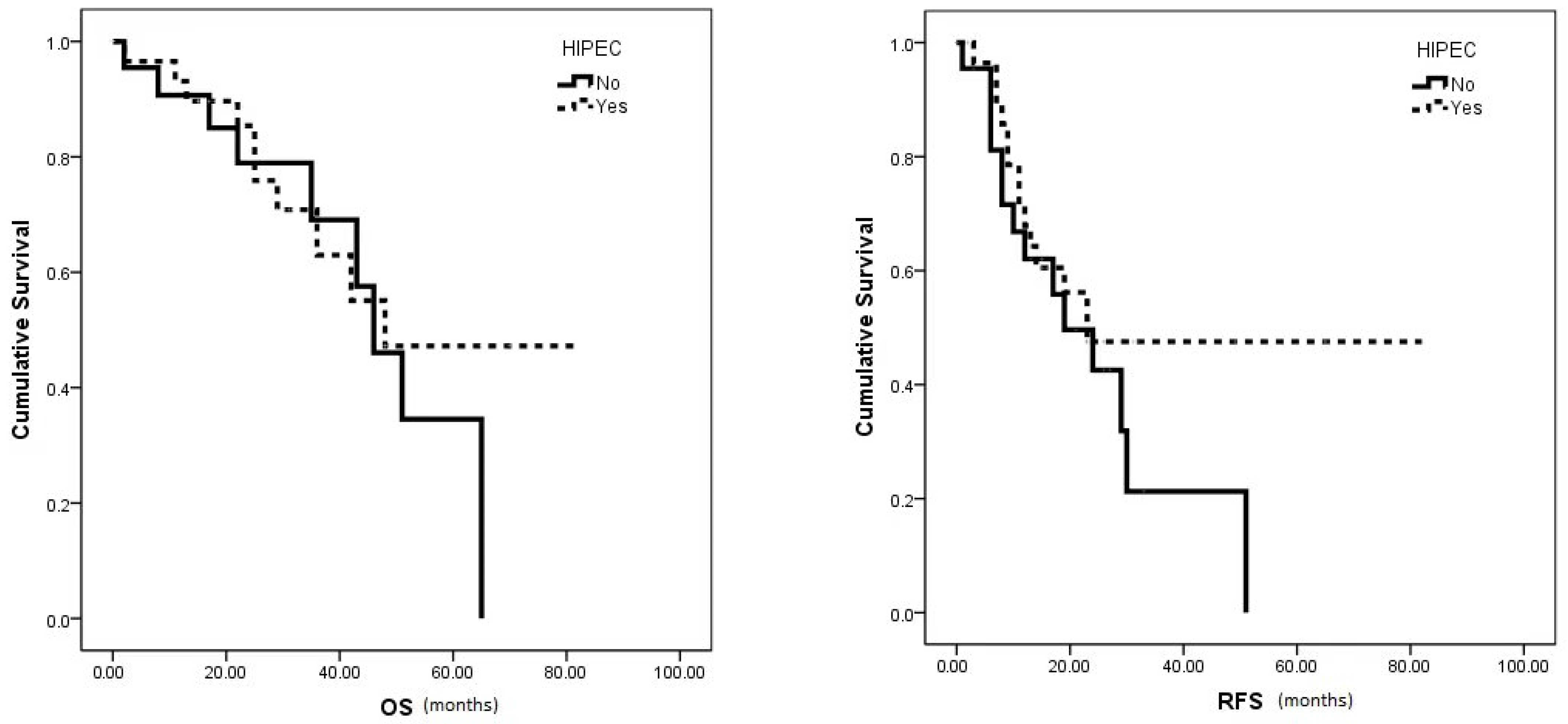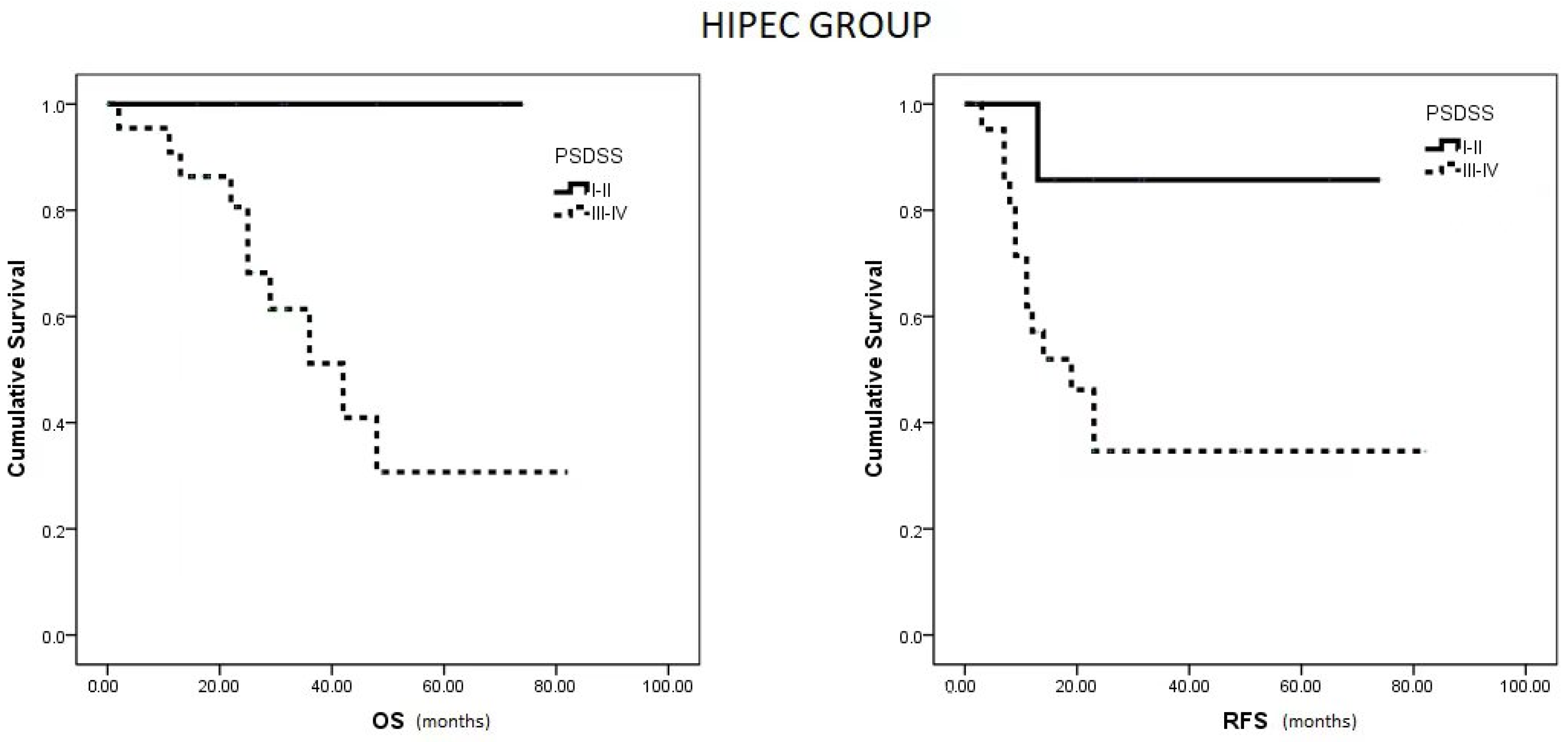Paclitaxel as HIPEC-Drug after Surgical Cytoreduction for Ovarian Peritoneal Metastases: A Randomized Phase III Clinical Trial (HIPECOVA)
Abstract
1. Introduction
2. Materials and Methods
2.1. Patients and Trial Design
2.2. Inclusion Criteria
- Female patients were eligible for inclusion if they were between 18 and 80 years of age and presented with histologically confirmed primary or recurrent EOC with peritoneal involvement. Women of childbearing age were required to have a negative pregnancy test to take part.
- Completeness of cytoreduction score (CC): CC0 (no visible residual tumor after surgery) or CC1 (less than 0.25 cm).
- No extra-abdominal tumor disease.
- Absence of heart failure. Adequate renal and hepatic function.
- Eastern Cooperative Oncology Group performance status of 0–2 or Karnofsky score ≥70%.
2.3. Exclusion Criteria
- Patients with unresectable disease or incomplete cytoreduction.
- Contraindications for treatment with paclitaxel: patients with severe hypersensitivity to paclitaxel or any of its excipients, pregnancy or lactation, and patients with baseline neutrophil counts <1500/mm3 (<1000/mm3 for patients with Kaposi sarcoma). Paclitaxel is also contraindicated in patients with concurrent severe infections such as the following:
- Extra-abdominal metastases or unresectable liver metastases;
- Presence of other malignant tumor disease;
- Multi-segmental complete bowel obstruction;
- Patients with severe medical conditions precluding compliance with the study or that introduce an unacceptable risk;
- Patients who refuse treatment or do not consent to participate in the study.
2.4. Treatment Groups and Follow-Up
- HIPEC arm: CRS and hyperthermic intraperitoneal chemotherapy with paclitaxel (175 mg/m2) for 60 min at a temperature of 42–43 °C (closed abdomen technique) followed by postoperative systemic intravenous (IV) chemotherapy with carboplatin (AUC = 6) and paclitaxel (175 mg/m2) for 6 cycles.
- Non-HIPEC arm: CRS followed by postoperative systemic IV chemotherapy with carboplatin (AUC = 6) and paclitaxel (175 mg/m2) for 6 cycles.
2.5. Endpoints
2.6. Statistical Analysis
3. Results
3.1. Patient Enrollment and Surgery-Related Characteristics
3.2. Survival Outcomes
3.3. Subgroup Analysis Based on PSDSS Score
3.4. Adverse Events
4. Discussion
5. Conclusions
Supplementary Materials
Author Contributions
Funding
Institutional Review Board Statement
Informed Consent Statement
Data Availability Statement
Acknowledgments
Conflicts of Interest
References
- Siegel, R.L.; Miller, K.D.; Jemal, A. Cancer statistics, 2018. CA Cancer J. Clin. 2018, 68, 7–30. [Google Scholar] [CrossRef] [PubMed]
- Kyrgiou, M.; Salanti, G.; Pavlidis, N.; Paraskevaidis, E.; Ioannidis, J.P. Survival benefits with diverse chemotherapy regimens for ovarian cancer: Meta-analysis of multiple treatments. J. Natl. Cancer Inst. 2006, 98, 1655–1663. [Google Scholar] [CrossRef] [PubMed]
- de Bree, E.; Michelakis, D.; Stamatiou, D.; Romanos, J.; Zoras, O. Pharmacological principles of intraperitoneal and bidirectional chemotherapy. Pleura Peritoneum 2017, 2, 47–62. [Google Scholar] [CrossRef] [PubMed]
- Jaaback, K.; Johnson, N. Intraperitoneal chemotherapy for the initial management of primary epithelial ovarian cancer. Cochrane Database Syst. Rev. 2016, 2016, CD005340. [Google Scholar] [CrossRef] [PubMed]
- Pelz, J.O.; Vetterlein, M.; Grimmig, T.; Kerscher, A.G.; Moll, E.; Lazariotou, M.; Matthes, N.; Faber, M.; Germer, C.T.; Waaga-Gasser, A.M.; et al. Hyperthermic intraperitoneal chemotherapy in patients with peritoneal carcinomatosis: Role of heat shock proteins and dissecting effects of hyperthermia. Ann. Surg. Oncol. 2013, 20, 1105–1113. [Google Scholar] [CrossRef] [PubMed]
- Halkia, E.; Tsochrinis, A.; Vassiliadou, D.T.; Pavlakou, A.; Vaxevanidou, A.; Datsis, A.; Efstathiou, E.; Spiliotis, J. Peritoneal carcinomatosis: Intraoperative parameters in open (coliseum) versus closed abdomen HIPEC. Int. J. Surg. Oncol. 2015, 2015, 610597. [Google Scholar] [CrossRef]
- Yurttas, C.; Hoffmann, G.; Tolios, A.; Haen, S.P.; Schwab, M.; Königsrainer, I.; Königsrainer, A.; Beckert, S.; Löffler, M.W. Systematic Review of Variations in Hyperthermic Intraperitoneal Chemotherapy (HIPEC) for Peritoneal Metastasis from Colorectal Cancer. J. Clin. Med. 2018, 7, 567. [Google Scholar] [CrossRef]
- de Bree, E.; Michelakis, D. An overview and update of hyperthermic intraperitoneal chemotherapy in ovarian cancer. Expert Opin. Pharmacother. 2020, 21, 1479–1492. [Google Scholar] [CrossRef]
- Van Driel, W.J.; Koole, S.N.; Sikorska, K.; Schagen van Leeuwen, J.H.; Schreuder, H.W.R.; Hermans, R.H.M.; De Hingh, I.H.; Van Der Velden, J.; Arts, H.J.; Massuger, L.F.; et al. Hyperthermic Intraperitoneal Chemotherapy in Ovarian Cancer. N. Engl. J. Med. 2018, 378, 230–240. [Google Scholar] [CrossRef]
- Spiliotis, J.; Halkia, E.; Lianos, E.; Kalantzi, N.; Grivas, A.; Efstathiou, E.; Giassas, S. Cytoreductive surgery and HIPEC in recurrent epithelial ovarian cancer: A prospective randomized phase III study. Ann. Surg. Oncol. 2015, 22, 1570–1575. [Google Scholar] [CrossRef]
- Sugarbaker, P.H. Intraperitoneal paclitaxel: Pharmacology, clinical results and future prospects. J. Gastrointest. Oncol. 2021, 12, S231–S239. [Google Scholar] [CrossRef] [PubMed]
- de Bree, E.; Rosing, H.; Filis, D.; Romanos, J.; Melisssourgaki, M.; Daskalakis, M.; Pilatou, M.; Sanidas, E.; Taflampas, P.; Kalbakis, K.; et al. Cytoreductive surgery and intraoperative hyperthermic intraperitoneal chemotherapy with paclitaxel: A clinical and pharmacokinetic study. Ann. Surg. Oncol. 2008, 15, 1183–1192. [Google Scholar] [CrossRef] [PubMed]
- Cascales-Campos, P.A.; Gil, J.; Gil, E.; Feliciangeli, E.; González-Gil, A.; Parrilla, J.J.; Parrilla, P. Treatment of microscopic disease with hyperthermic intraoperative intraperitoneal chemotherapy after complete cytoreduction improves disease-free survival in patients with stage IIIC/IV ovarian cancer. Ann. Surg. Oncol. 2014, 21, 2383–2389. [Google Scholar] [CrossRef] [PubMed]
- Rufián, S.; Muñoz-Casares, F.C.; Briceño, J.; Díaz, C.J.; Rubio, M.J.; Ortega, R.; Ciria, R.; Morillo, M.; Aranda, E.; Muntané, J.; et al. Radical surgery-peritonectomy and intraoperative intraperitoneal chemotherapy for the treatment of peritoneal carcinomatosis in recurrent or primary ovarian cancer. J. Surg. Oncol. 2006, 94, 316–324. [Google Scholar] [CrossRef] [PubMed]
- Cascales-Campos, P.; López-López, V.; Gil, J.; Arévalo-Pérez, J.; Nieto, A.; Barceló, F.; Gil, E.; Parrilla, P. Hyperthermic intraperitoneal chemotherapy with paclitaxel or cisplatin in patients with stage III-C/IV ovarian cancer. Is there any difference? Surg. Oncol. 2016, 25, 164–170. [Google Scholar] [CrossRef] [PubMed]
- Manzanedo, I.; Pereira, F.; Serrano, Á.; Pérez-Viejo, E.; Martínez-Torres, B.; Carrión, L.; Calzas, J. The use of cisplatin plus doxorubicin or paclitaxel in hyperthermic intraperitoneal chemotherapy (HIPEC) for stage IIIC or IV epithelial ovarian cancer: A comparative study. Clin. Transl. Oncol. 2019, 21, 1357–1363. [Google Scholar] [CrossRef] [PubMed]
- Pascual-Ramírez, J.; Sánchez García, S.; González Ruiz de la Herrán, F.; Villarejo Campos, P.; López de la Manzanara Cano, C.; Haya Palazuelo, J.; Padilla Valverde, D.; Martín Fernández, J. Security and efficiency of a closed-system, turbulent-flow circuit for hyperthermic intraperitoneal chemotherapy after cytoreductive ovarian surgery: Perioperative outputs. Arch. Gynecol. Obstet. 2014, 290, 121–129. [Google Scholar] [CrossRef]
- Sánchez-García, S.; Padilla-Valverde, D.; Villarejo-Campos, P.; Martín-Fernández, J.; García-Rojo, M.; Rodríguez-Martínez, M. Experimental development of an intra-abdominal chemohyperthermia model using a closed abdomen technique and a PRS-1.0 Combat CO2 recirculation system. Surgery 2014, 155, 719–725. [Google Scholar] [CrossRef]
- Padilla-Valverde, D.; Sanchez-Garcia, S.; García-Santos, E.; Marcote-Ibañez, C.; Molina-Robles, M.; Martín-Fernández, J.; Villarejo-Campos, P. Usefulness of thermographic analysis to control temperature homogeneity in the development and implementation of a closed recirculating CO2 chemohyperthermia model. Int. J. Hyperth. 2017, 33, 220–226. [Google Scholar] [CrossRef][Green Version]
- Simkens, G.A.; Wintjens, A.G.W.E.; Rovers, K.P.; Nienhuijs, S.W.; de Hingh, I.H. Effective Strategies to Predict Survival of Colorectal Peritoneal Metastases Patients Eligible for Cytoreductive Surgery and HIPEC. Cancer Manag. Res. 2021, 13, 5239–5249. [Google Scholar] [CrossRef]
- Foster, J.M.; Sleightholm, R.; Smith, L.; Ceelen, W.; Deraco, M.; Yildirim, Y.; Levine, E.; Muñoz-Casares, C.; Glehen, O.; Patel, A.; et al. The American Society of Peritoneal Surface Malignancies Multi-Institution evaluation of 1,051 advanced ovarian cancer patients undergoing cytoreductive surgery and HIPEC: An introduction of the peritoneal surface disease severity score. J. Surg. Oncol. 2016, 114, 779–784. [Google Scholar] [CrossRef] [PubMed]
- Pedro Antonio, C.C.; Álvaro Jesús, G.R.; José, G.; Elena, G.; Alida, G.; Francisco, M.L.; Guillermo, C.D.C.; Pascual, P. Validation of a peritoneal surface disease severity score in stage IIIC-IV ovarian cancer treated with cytoreduction and hyperthermic intraperitoneal chemotherapy. Surg. Oncol. 2019, 28, 57–61. [Google Scholar] [CrossRef] [PubMed]
- Prat, J.; FIGO Committee on Gynecologic Oncology. FIGO’s staging classification for cancer of the ovary, fallopian tube, and peritoneum: Abridged republication. J. Gynecol. Oncol. 2015, 26, 87–89. [Google Scholar] [CrossRef] [PubMed]
- Jónsdóttir, B.; Lomnytska, M.; Poromaa, I.S.; Silins, I.; Stålberg, K. The Peritoneal Cancer Index is a Strong Predictor of Incomplete Cytoreductive Surgery in Ovarian Cancer. Ann. Surg. Oncol. 2021, 28, 244–251. [Google Scholar] [CrossRef] [PubMed]
- Elattar, A.; Bryant, A.; Winter-Roach, B.A.; Hatem, M.; Naik, R. Optimal primary surgical treatment for advanced epithelial ovarian cancer. Cochrane Database Syst. Rev. 2011, 8, CD007565. [Google Scholar] [CrossRef] [PubMed]
- Al Rawahi, T.; Lopes, A.D.; Bristow, R.E.; Bryant, A.; Elattar, A.; Chattopadhyay, S.; Galaal, K. Surgical cytoreduction for recurrent epithelial ovarian cancer. Cochrane Database Syst. Rev. 2013, 2, CD008765. [Google Scholar] [CrossRef]
- Lim, M.C.; Chang, S.J.; Park, B.; Yoo, H.J.; Yoo, C.W.; Nam, B.H.; Park, S.Y. Survival after Hyperthermic Intraperitoneal Chemotherapy and Primary or Interval Cytoreductive Surgery in Ovarian Cancer: A Randomized Clinical Trial. JAMA Surg. 2022, 157, 374–383. [Google Scholar] [CrossRef]
- Antonio, C.C.P.; Alida, G.G.; Elena, G.G.; Rocío, G.S.; Jerónimo, M.G.; Luis, A.R.J.; Aníbal, N.D.; Francisco, B.V.; Jesús, G.R.Á.; Pablo, R.R.; et al. Cytoreductive Surgery With or Without HIPEC After Neoadjuvant Chemotherapy in Ovarian Cancer: A Phase 3 Clinical Trial. Ann. Surg. Oncol. 2022, 29, 2617–2625. [Google Scholar] [CrossRef]
- Zivanovic, O.; Chi, D.S.; Zhou, Q.; Iasonos, A.; Konner, J.A.; Makker, V.; Grisham, R.N.; Brown, A.K.; Nerenstone, S.; Diaz, J.P.; et al. Secondary Cytoreduction and Carboplatin Hyperthermic Intraperitoneal Chemotherapy for Platinum-Sensitive Recurrent Ovarian Cancer: An MSK Team Ovary Phase II Study. J. Clin. Oncol. 2021, 39, 2594–2604. [Google Scholar] [CrossRef]
- Mehta, S.S.; Gelli, M.; Agarwal, D.; Goéré, D. Complications of Cytoreductive Surgery and HIPEC in the Treatment of Peritoneal Metastases. Indian J. Surg. Oncol. 2016, 7, 225–229. [Google Scholar] [CrossRef]



| HIPEC | NO HIPEC | p-Value | |
|---|---|---|---|
| AGE (years) | 60.34 (±11.7) | 60.22 (±12.93) | 0.969 |
| BMI (kg/m2) | 27.96 (±4.63) | 26.46 (±4.62) | 0.255 |
| AH | 15 (27.3%) | 6 (10.9%) | 0.118 |
| DM | 6 (10.9%) | 2 (3.6%) | 0.446 |
| ASA | 0.3 | ||
| - I | - 3 (5.5%) | - 4 (7.3%) | |
| - II | - 18 (32.7%) | - 14 (25.5%) | |
| - III | - 11 (20%) | - 4 (7.3%) | |
| - IV | - 0 (0%) | - 1 (1.8%) | |
| TUMOR HISTOLOGIC TYPE | 0.878 | ||
| - Serous | - 24 (43.6%) | - 16 (29.1%) | |
| - Mucinous | - 3 (5.5%) | - 1 (1.8%) | |
| - Endometrioid | - 2 (3.6%) | - 2 (3.6%) | |
| - Clear-cell | - 2 (3.6%) | - 3 (5.5%) | |
| - Other | - 1 (1.8%) | - 1 (0.8%) | |
| SURGERY TYPE | 0.118 | ||
| - Primary surgery | - 12 (21.8%) | - 14 (25.5%) | |
| - Interval surgery | - 19 (34.5%) | - 7 (12.7%) | |
| - Secondary surgery | - 1 (1.8%) | - 2 (3.6%) | |
| HISTOLOGIC GRADE | 0.234 | ||
| - Low grade | - 4 (7.3%) | - 0 (0%) | |
| - Intermediate grade | - 9 (16.4%) | - 7 (12.7%) | |
| - High grade | - 19 (34.5%) | - 16 (29.1%) | |
| LYMPH NODES | 0.783 | ||
| - Positive | - 13 (23.6%) | - 11 (20%) | |
| - Negative | - 19 (34.5%) | - 12 (21.8%) | |
| FIGO STAGE | 0.929 | ||
| - IIa | - 3 (5.5%) | - 2 (3.6%) | |
| - IIb | - 2 (3.6%) | - 1 (1.8%) | |
| - IIIa | - 1 (1.8%) | - 1 (1.8%) | |
| - IIIb | - 1 (1.8%) | - 2 (3.6%) | |
| - IIIc | - 16 (29.1%) | - 14 (25.5%) | |
| - IVa | - 3 (5.5%) | - 1 (1.8%) | |
| - IVb | - 6 (19.9%) | - 2 (3.6%) | |
| CT-PET PCI | 0.666 | ||
| - <10 | - 19 (35.2%) | - 14 (25.9%) | |
| - 11–20 | - 11 (20.4%) | - 7 (13%) | |
| - >20 | - 1 (1.9%) | - 2 (3.7%) | |
| Surgery PCI | 0.72 | ||
| - <10 | - 22 (40%) | - 14 (25.9%) | |
| - 11–20 | - 8 (14.5%) | - (14.5%) | |
| - >20 | - 2 (3.6%) | - 1 (1.8%) |
| Author and Year | Clinical Trial | N | Surgery | HIPEC Drug (mg/m2) | HIPEC (minutes) | Median PFS or DFS or RFS (months) | Median OS (months) | p-Value |
|---|---|---|---|---|---|---|---|---|
| Lim (2022) [27] | 2 center Phase III KOV-HIPEC-01 | 184 | Primary and Interval Interval subgroup | Cisplatin 75 | 90 | 19.8 vs. 18.8 17.4 vs. 15.4 | 69.5 vs. 61.3 61.8 vs. 48.2 | p > 0.05 p < 0.05 |
| Cascales (2022) [28] | Single-center Phase III CARCINOHIPEC | 71 | Interval Subgroup with supramesocolic disease | Cisplatin 75 | 60 | 18 vs. 12 24.1 vs. 9.4 | 52 vs. 45 | p > 0.05 p < 0.05 |
| Zivanovic (2021) [29] | Single-center Phase II | 98 | Secondary for platinum-sensitive | Carboplatin 800 | 90 | 15.7 vs. 12.3 | 59.7 vs. 52.5 | p ≥ 0.05 |
| Driel (2018) [9] | Multicenter Phase III OVHIPEC | 245 | Interval | Cisplatin 100 | 90 | 14.2 vs. 10.7 | 45.7 vs. 33.9 | p < 0.05 |
| Spiliotis (2015) [10] | Single-center Phase III | 120 | Secondary for platinum-sensitive and resistant | Cisplatin 100 Paclitaxel 175 Doxorubicin 35 Mitomycin 15 | 60 | 26.7 vs. 13.4 | p < 0.05 |
Disclaimer/Publisher’s Note: The statements, opinions and data contained in all publications are solely those of the individual author(s) and contributor(s) and not of MDPI and/or the editor(s). MDPI and/or the editor(s) disclaim responsibility for any injury to people or property resulting from any ideas, methods, instructions or products referred to in the content. |
© 2024 by the authors. Licensee MDPI, Basel, Switzerland. This article is an open access article distributed under the terms and conditions of the Creative Commons Attribution (CC BY) license (https://creativecommons.org/licenses/by/4.0/).
Share and Cite
Villarejo Campos, P.; Sánchez García, S.; Amo-Salas, M.; García Santos, E.; López de la Manzanara, C.; Alberca, A.; Padilla-Valverde, D.; Redondo Calvo, F.J.; Martín, J. Paclitaxel as HIPEC-Drug after Surgical Cytoreduction for Ovarian Peritoneal Metastases: A Randomized Phase III Clinical Trial (HIPECOVA). Curr. Oncol. 2024, 31, 660-671. https://doi.org/10.3390/curroncol31020048
Villarejo Campos P, Sánchez García S, Amo-Salas M, García Santos E, López de la Manzanara C, Alberca A, Padilla-Valverde D, Redondo Calvo FJ, Martín J. Paclitaxel as HIPEC-Drug after Surgical Cytoreduction for Ovarian Peritoneal Metastases: A Randomized Phase III Clinical Trial (HIPECOVA). Current Oncology. 2024; 31(2):660-671. https://doi.org/10.3390/curroncol31020048
Chicago/Turabian StyleVillarejo Campos, Pedro, Susana Sánchez García, Mariano Amo-Salas, Esther García Santos, Carlos López de la Manzanara, Ana Alberca, David Padilla-Valverde, Francisco Javier Redondo Calvo, and Jesús Martín. 2024. "Paclitaxel as HIPEC-Drug after Surgical Cytoreduction for Ovarian Peritoneal Metastases: A Randomized Phase III Clinical Trial (HIPECOVA)" Current Oncology 31, no. 2: 660-671. https://doi.org/10.3390/curroncol31020048
APA StyleVillarejo Campos, P., Sánchez García, S., Amo-Salas, M., García Santos, E., López de la Manzanara, C., Alberca, A., Padilla-Valverde, D., Redondo Calvo, F. J., & Martín, J. (2024). Paclitaxel as HIPEC-Drug after Surgical Cytoreduction for Ovarian Peritoneal Metastases: A Randomized Phase III Clinical Trial (HIPECOVA). Current Oncology, 31(2), 660-671. https://doi.org/10.3390/curroncol31020048






